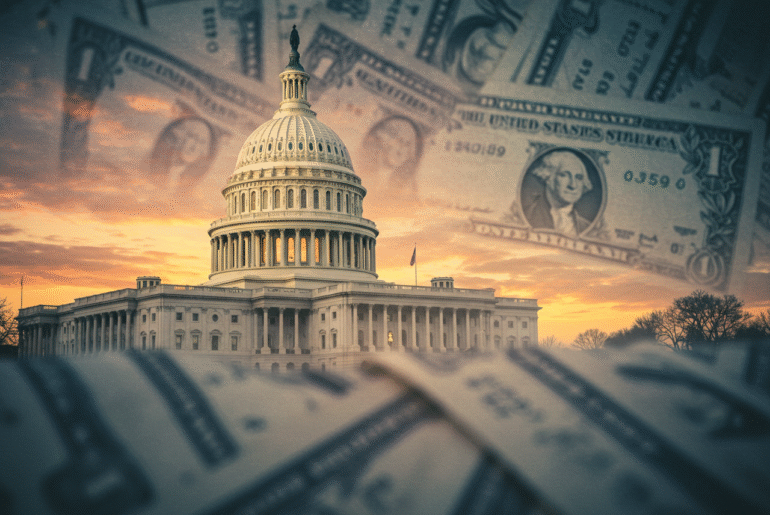This article may contain references to products or services from one or more of our advertisers or partners. We may receive compensation when you click on links to those products or services. Nonetheless, our opinions are our own.
The information presented in this article is accurate to the best of our knowledge at the time of publication. However, information is subject to change, and no guarantees are made about the continued accuracy or completeness of this content after its publication date.
- Introduction
- U.S. Debt and International Relations
- Who Really Owns America’s $36 Trillion Debt? Treasury and CRS Break It Down
- Public Debt Compared to Private Debt
- Global Debt Events and Lessons
- Ownership of U.S. Debt
- Global Comparison of U.S. Indebtedness
-
Frequently Asked Questions
- What is meant by stating there is no U.S. debt crisis?
- How does inflation play into the discussion about U.S. debt?
- What are some myths surrounding the U.S. debt?
- What are the potential risks of ignoring national debt?
- What role do interest rates play in the U.S. debt scenario?
- How should the U.S. approach its debt moving forward?
- Impacts of Non-Economic Policies on Debt
- Final Thoughts on U.S. Debt and Policy
- Recommended Reads
Introduction
The national debt of the United States, a complex financial construct, represents the total amount of money that the government owes to its creditors. This debt is typically categorized into two main components: public debt and intragovernmental holdings. Public debt includes money borrowed from external investors, both domestic and foreign, while intragovernmental holdings consist of funds owed to various federal programs, such as Social Security. Understanding the implications of U.S. debt is important for grasping the nation’s economic health and its position in the global financial landscape.
U.S. Debt and International Relations
The role of U.S. debt extends beyond mere numbers on a balance sheet; it is a pivotal element in the landscape of international relations and geopolitics. As one of the largest economies in the world, the United States’ borrowing practices significantly influence global markets and diplomatic ties. Countries that hold substantial amounts of U.S. Treasury securities, such as China and Japan, have a vested interest in maintaining stable financial relations with the U.S., often using their holdings as leverage in diplomatic negotiations. Furthermore, fluctuations in U.S. debt can have ripple effects, impacting global interest rates, currency values, and trade balances.
Who Really Owns America’s $36 Trillion Debt? Treasury and CRS Break It Down
According to the U.S. Department of the Treasury, dated June 30, 2025, the United States had approximately $28.8 trillion in debt held by the public and about $7.26 trillion in intragovernmental holdings, resulting in a total national debt of nearly $36 trillion. This includes money owed to external investors such as individuals, institutions, and foreign governments, as well as internal government accounts like Social Security. The Congressional Research Service, in a June 2025 update, noted that about 24% of the public debt is held by foreign investors, with the remaining portion largely owned by domestic entities. These include mutual funds, pension funds, and the Federal Reserve. In contrast, intragovernmental debt reflects money the government owes itself, primarily for federal trust funds. These figures underline that most U.S. debt is domestically held, not foreign-owned, helping to counter common misconceptions.
Public Debt Compared to Private Debt
While U.S. debt often conjures images of government borrowing, it is important to differentiate between public and private debt. Public debt pertains to what the federal government owes, directly impacting national fiscal policy and economic stability. Conversely, private debt encompasses loans taken on by individuals and businesses, shaping consumption patterns and investment potential within the economy. Citizens should be aware that high levels of public debt can lead to increased taxes and reduced government spending, while excessive private debt may limit household purchasing power and business expansion, thus affecting overall economic vitality.
Voted "Best Overall Budgeting App" by Forbes and WSJ
Monarch Money helps you budget, track spending, set goals, and plan your financial future—all in one app.
Get 50% OFF your first year with code MONARCHVIP
Global Debt Events and Lessons
Examining historical debt crises around the world provides invaluable insights into the potential pitfalls of excessive borrowing. For instance, countries like Greece and Argentina have faced dire consequences when public debt spiraled out of control, leading to austerity measures, social unrest, and diminished economic performance. These cases serve as cautionary tales, illustrating how unchecked debt levels can erode investor confidence and destabilize economies. Moreover, understanding the interconnectedness of global finance highlights how a crisis in one nation can have ripple effects worldwide, potentially impacting even the most stable economies.
Ownership of U.S. Debt
A common misconception is that foreign entities hold the majority of U.S. debt; however, the reality is more nuanced. The largest portion of U.S. public debt is owned by domestic investors, including individual citizens, private pension funds, and institutional investors like banks and mutual funds. While foreign nations, most notably Japan and China, are significant holders, they own only a fraction of the total debt. This domestic ownership plays a role in determining interest rates and economic policy, as it implies a strong internal stake in the nation’s financial stability.
Global Comparison of U.S. Indebtedness
A broader measure of indebtedness shows the U.S. is fairly typical. This perspective challenges the notion that the U.S. faces an unprecedented or uniquely dire debt situation compared to other developed nations. When examining factors beyond just federal government debt, such as household and corporate debt, the overall picture of U.S. indebtedness aligns more closely with global averages. This broader view helps to contextualize the U.S. debt position within the global economic landscape, suggesting that while the absolute numbers are large, the relative burden may not be an outlier.
Frequently Asked Questions
What is meant by stating there is no U.S. debt crisis?
Many analysts argue that the current state of U.S. debt, while high, does not equate to a crisis. The U.S. government has the ability to manage its debt through monetary policy, including borrowing and tax adjustments. Additionally, the dollar’s status as the world’s reserve currency provides a unique ability to service debt without immediate financial repercussions or a loss of investor confidence that would typically signify a crisis. This flexibility allows for strategic debt management.
How does inflation play into the discussion about U.S. debt?
Inflation can significantly impact the real value of debt. If the inflation rate is higher than the interest rate on the debt, the real burden of that debt diminishes over time. This creates a scenario where inflation can actually alleviate some of the pressure associated with high levels of debt by reducing the purchasing power of the money owed. However, uncontrolled inflation can also lead to economic instability.
What are some myths surrounding the U.S. debt?
One common myth is that the U.S. will eventually default on its debt. In reality, the government can always meet its debt obligations by managing its currency and making adjustments as needed, such as raising the debt ceiling or implementing fiscal policy changes. Another myth is that high debt directly leads to higher taxes; while this can happen, it is not an inevitable outcome, as other fiscal measures can be employed.
What are the potential risks of ignoring national debt?
Ignoring national debt can lead to several risks, including increased interest rates, a decline in investor confidence, and potential inflationary pressures. If the government does not adopt a responsible approach to fiscal policy, there could be long-term economic ramifications, such as slower economic growth, reduced public services due to higher interest payments, and a weakened international standing.
What role do interest rates play in the U.S. debt scenario?
Interest rates are important because they influence the government’s cost of borrowing. When rates are low, borrowing can be more manageable, whereas rising rates would significantly increase the cost of servicing existing debt and new debt issuance. This is vital for the ongoing health of the economy and national debt management, as higher interest payments can divert funds from other government programs.
How should the U.S. approach its debt moving forward?
A balanced approach is important for managing U.S. debt moving forward. This includes adopting fiscal policies that encourage economic growth while also ensuring that government spending remains manageable and sustainable. Investments in sectors like infrastructure, education, and research can foster long-term economic expansion that helps to offset the challenges posed by debt, rather than solely focusing on austerity measures.
Impacts of Non-Economic Policies on Debt
Non-economic policies, such as geopolitical events, trade disputes, or even social policy shifts, can have significant, often indirect, impacts on U.S. debt and interest rates. For instance, increased global instability might lead foreign investors to seek the safety of U.S. Treasury securities, driving down interest rates due to higher demand. Conversely, prolonged trade wars could dampen economic growth, reducing tax revenues and increasing the need for government borrowing, thus impacting debt levels and potentially raising interest rates. These non-economic factors add layers of complexity to debt management.
Final Thoughts on U.S. Debt and Policy
The U.S. national debt is a multifaceted issue with far-reaching implications for domestic economic stability and international relations. A comprehensive understanding requires moving beyond simplistic interpretations and recognizing the interplay of public and private debt, the lessons from global financial crises, and the nuanced ownership structure of the debt. Effective management necessitates a balanced approach, considering both economic and non-economic factors that influence the nation’s fiscal health. Continued vigilance and adaptive strategies are paramount to ensuring long-term financial resilience.

Reviewed and edited by Albert Fang.
See a typo or want to suggest an edit/revision to the content? Use the contact us form to provide feedback.
At FangWallet, we value editorial integrity and open collaboration in curating quality content for readers to enjoy. Much appreciated for the assist.
Did you like our article and find it insightful? We encourage sharing the article link with family and friends to benefit as well - better yet, sharing on social media. Thank you for the support! 🍉
Article Title: Is the U.S. National Debt a Problem in 2025?
https://fangwallet.com/2025/07/27/is-the-u-s-national-debt-a-problem-in-2025/The FangWallet Promise
FangWallet is an editorially independent resource - founded on breaking down challenging financial concepts for anyone to understand since 2014. While we adhere to editorial integrity, note that this post may contain references to products from our partners.
The FangWallet promise is always to have your best interest in mind and be transparent and honest about the financial picture.
Become an Insider

Subscribe to get a free daily budget planner printable to help get your money on track!
Make passive money the right way. No spam.
Editorial Disclaimer: The editorial content on this page is not provided by any of the companies mentioned. The opinions expressed here are the author's alone.
The content of this website is for informational purposes only and does not represent investment advice, or an offer or solicitation to buy or sell any security, investment, or product. Investors are encouraged to do their own due diligence, and, if necessary, consult professional advising before making any investment decisions. Investing involves a high degree of risk, and financial losses may occur including the potential loss of principal.
Source Citation References:
+ Inspo
U.S. Department of the Treasury. Bureau of the Fiscal Service. (2025, June 30). Monthly Statement of the Public Debt of the United States (footnotes). U.S. Department of the Treasury.
Congressional Research Service. (2025, June). Foreign Holdings of Federal Debt (CRS Report).












































